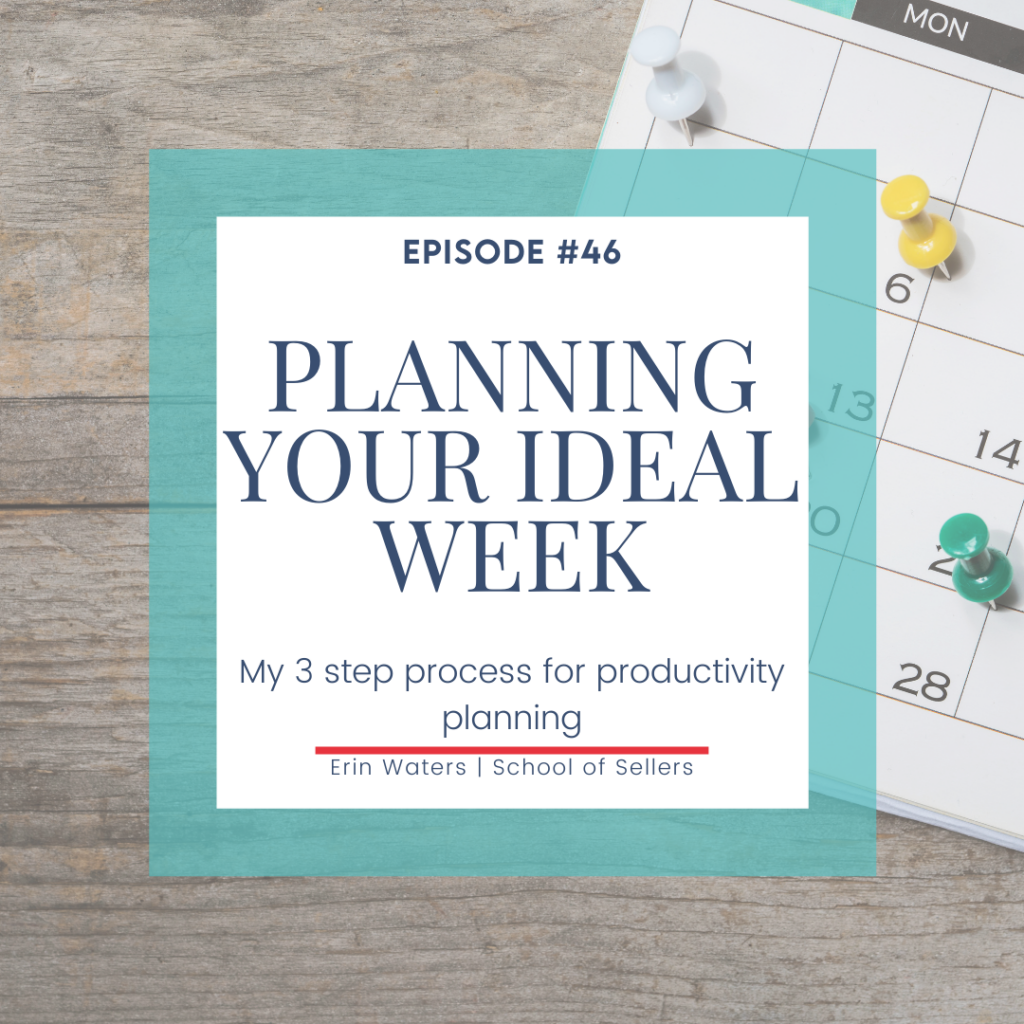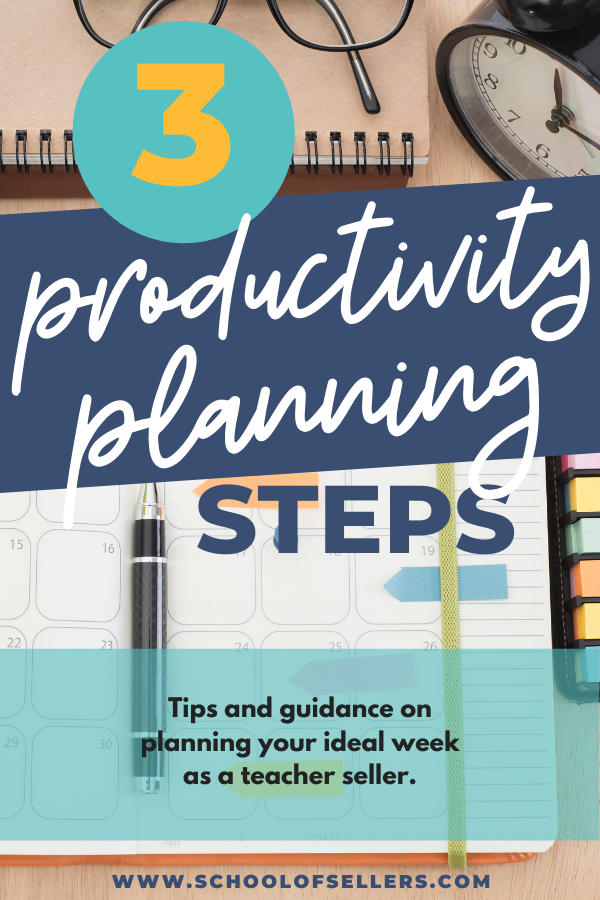Episode Summary
Planning your week effectively is one of the most important things you can do for your teacher business. In this episode, I share my exact process for planning my ideal work week and walk you through a quick but effective system for making every day count.

This post may contain affiliate links. As an Amazon Associate, I earn from qualifying purchases.
Today we are talking about one of my favorite topics. Before we get started, I wanted to let you know that this episode is actually dedicated to a very special group of people. That group is my students of the Finishing Framework who have just officially graduated the program as of last week. If you aren’t familiar with the Finishing Framework, it’s a program that shows sellers how to organize their business assets and make their teacher businesses work harder for them. We also teach students how to use a Framework to mega batch everything from emails to blog posts so that our time is freed up for what most of us love to do which is creating products.
The reason I’m dedicating this is because our last module just wrapped up. These teacher sellers have been working so hard to clear their schedules and free up their time to create. So I thought that I would celebrate by talking about one of my favorite topics which is planning. And in this case, we are going to be talking about how we plan out our week, how to do it, what it looks like, where to start, and we are just talking about all things planning. So let’s get started.
Plan Your Ideal Work Week with The Big Picture
In general, I think there are three main layers to planning out the perfect week. And the very first layer starts with the big picture. I think that all of us, no matter what it looks like and how we do it, should have a business plan laid out. In my case, I like having a business plan that is laid out for the entire year and then I break that down further by quarter. And this is actually what we do in our jump start planning event that we have every December for School of Sellers.
We sit down and we plan out our content creation, what we’re going to create product wise, what we’re going to blog about, what we’re going to send emails about, and we have this plan laid out for the whole entire year. And this even includes what we’ll post about on social media. We get pretty specific. Just knowing all of this in the big picture rather than waiting every single month to plan out what it is you’re going to do has allowed me to do so much in my business.

Having this big picture plan has allowed me to start mega batching a lot of my work. The more I know ahead of time, the more I’m able to prepare. So being able to mega batch has been a huge thing in my business. And this not only leaves me with tons of wide open time but it also gives me the peace of mind knowing that what I need to do has already been done and I can actually look beyond my typical to-do list to see what I can do next.
You Can’t Plan for Everything, But You Can Try
I can sit here and tell you about how much I love mega batching and the Framework until I’m blue in the face. And the great thing is that I typically have a pretty good idea of what I’m doing every single day. But the truth remains that no matter what plans you have, no matter what your business plans look like, life still unfolds in real time. So no matter what you plan for, there are still some unknowns that will pop up.
And an unexpected side effect of mega batching is a feeling of did I forget something. Because when you mass produce something in advance you kind of lose that feeling of being in real time with your business and you start to worry. You know you got everything done but you start to feel like, oh, did I do that? I know I did that but I’m kind of wondering if I definitely did that. And spoiler alert, you probably aren’t forgetting anything. But the good news is that my weekly planning system is going to give you that great peace of mind.
Plan Your Ideal Week with Weekly Structure
Once we have our big picture, we are ready to sit down and actually take a look at the weekly structure. And the second layer of planning out your week comes from an icon in the business world that I’ve been following for years. His name is Michael Hyatt and he has coined the term your ideal week. And I think this is one of the most crucial parts of having a plan and a schedule that works for you is sitting down and crafting out your own ideal week.
Your ideal week is exactly what it sounds like. If you had one entire week that went according to plan 100%, what would that look like for you? What would that look like from a personal standpoint? A business standpoint? What would your perfect week look like? You’re essentially designing a prototype for what you wish every week of your life looked like. And this isn’t some like daydream activity. This is a very realistic planning activity. So you want to be realistic as you design your ideal week.
Be Realistic About Your Time
I want you to be realistic in two ways. Even though it’s ideal, I want you to make every second count in your pretend plan because you know that it’s not actually pretend. Don’t let your imagination run away with itself. Make sure that you are sticking to what you actually need to accomplish in your ideal week. And also, know that you won’t do every single thing every single week. But if you could, what would that look like?
It’s definitely a delicate balancing act between wanting to schedule your ideal week with things that you wish were getting done every week but also being aware that it’s not always possible. But even just the act of sitting down to decide what your ideal week would look like is a very powerful experience. You don’t need to spend any longer than 10 minutes if you don’t want. But just sitting down and reflecting on these ideas is something that’s really going to help as you plan out your week to week schedule from here on out.
I’ve actually included a template for setting up your perfect week. It’s just a simple Google Sheets, not anything fancy. You can do the same thing in PowerPoint or use good old-fashioned paper and pencil. It’s literally just a grid of days and time slots. I like to get super specific when I plan out my ideal week. So I like to break it down into half hour time slots. But you can also do it by the hour if you wish.
Once you’ve sketched out your ideal week, you have a prototype or a template for what your week will look like every single week going forward. This is something that you should constantly be fine-tuning and adjusting as you think of new things to add to it but you should also keep this close by for layer number three which is the week by week planning part of our process.
Plan Your Ideal Week with a Power Hour
Our third layer of the planning process is something I like to call my weekly power hour and I actually use power hours for a lot of different purposes. But a power hour is pretty much what it sounds like. You set the timer for an hour and you have only 60 minutes to get done whatever it is that you were trying to tackle. Once you reach this layer of the planning process, just to review, you have your entire year, you have this longer term business plan. So you have the big picture in mind and you’ve also sat down and sketched out what your ideal week would look like. So our third layer now is actually sitting down and deciding what your actual week is going to look like.
Gather Your Serious Planning Materials
The reason I do a power hour for this is because it’s something that is really important for me to address every single week but it’s not something I want to obsess over. So typically for me, I sit down either every Sunday or every Monday morning and I set the timer for 60 minutes. And at this point, I have my ideal week in mind and I even have it next to me as I plan out my week. I have my calendar and any other planning or scheduling tools that you would typically use. I have our School of Sellers planner and I also have my iPad because I use GoodNotes. So at this point, you want all of the planning materials. Maybe you’re a sticky notes person. Get that cup of coffee going. This is where it gets real.
And like I said, this can be done on any day of the week and every time I do this, I always think of this old quote. I don’t even, I’m probably going to butcher it but it’s something along the lines of, a Sunday well spent brings a week of content. Right? And that is so old school, so old fashioned. But I will say that the weeks that I don’t do this, it is painfully obvious to me how much differently my week goes. So even just spending an hour to sit down and plan out your week can have really powerful results. So I would recommend trying to do this whenever possible.
Add Your Obligations
So we have our big picture plans. We have our ideal week. But even with the best laid plans, life happens. This is a really good way to check in with yourself, your family, and your business on a week-to-week basis. So with my power hour, the first thing I sit down to do is plug in everything that I need to do that week. This is just a collection of actual obligations, whether these are appointments or meetings or deadlines. These are physical things that I have to do that involve other people or that I need to have done by a certain date. These are very black and white items.
Examples of this would be my mastermind meetings that I have every other week. Or appointments that I might have for my kids’ doctor’s appointments or whatever. Once I have obligations written in, which in general I already usually have written down in my calendar so at this point I am just taking anything from my calendar and putting them into my Trello cards because I like to use Trello for my weekly plans. I have one card for every single week that is called week at a glance so that I can quickly reference that week only.
Recurring Tasks
Then I consult my recurring tasks list which is something that we just set up in the Finishing Framework course. But essentially, I have an Airtable where all of my tasks are documented. I’ve created check boxes to designate them as daily, weekly, monthly, etc. Once I have my appointments and deadlines plugged in, I sit down and see where I can add recurring tasks. And some of these examples would be things like daily recurring tasks, would be things like checking in with my Facebook groups, answering questions on TpT, things like that.
Weekly examples would be things like applying for the TpT newsletter. For monthly, these are things like paying your VAs, checking data and analytics from the previous month, updating your content calendar, etc. Currently, I’m testing out block scheduling. So my days kind of fall into categories. Monday is when I take care of a lot of my VA stuff. Tuesday is dedicated to social media and so on. So when I sit down with my recurring tasks, I typically dump them in to the days where they fit. I already have a list of Monday tasks and Tuesday tasks and so on that I paste into my weekly schedule. But yours might be a little bit more randomized.
Recurring Tasks If You’re Still Teaching
If you are somebody who is still in the classroom and you are teaching full-time, something I might recommend is taking all of your recurring tasks and trying to either get one done every single day and setting a timer for like 10 minutes or getting all of your recurring tasks and tackling them all in one day for two hours. That way they’re done in one fell swoop. But of course, that is totally up to your personal preference.
No matter what day I plug these tasks into, for the more mundane tasks like answering Q&As, I definitely plan to set a timer so that I only spend x number of minutes every day on these things. When I plug these into my schedule, I will make a note if these are things that I’m going to be timed. So I’m just going to put the number 10 in parentheses next to these items so that I know that these are just 10 minute tasks.
Add the Things You Want to Work On
Once you’ve plugged in your obligations and then your recurring tasks, then comes the fun part. You’re done with all of the stuff you need to do and all of the housekeeping tasks. So now you get to decide what you’re working on this week. It’s important to refer to your ideal week that you laid out so that you stay as close to it as possible. It’s ideal for a reason. Try to plan out the rest of your week with the lens of your ideal week.
I get really excited about the idea of creating products and different projects for School of Sellers. So I typically reserve my mornings for creative work like that. And then any recurring tasks that I have, I plan out for a part of the day where I’m not feeling so motivated because I know I’m just going to be setting a timer and getting it done so I’m not too worried about enjoying it.
So beyond my obligations and my recurring tasks, in any given week, I typically have like one TpT product I’m working on, one marketing project whether that’s something like creating a new Facebook ad campaign for a certain product or whatever. I usually have one School of Sellers project I’m working on and things like that. So the rest of my plans here are usually project based and things that are more enjoyable and fun and creative for me to work on.
If you have mega batched your blog posts and emails and social media posts, then this is where you also get to plug in all of the fun creative projects that you are working on from week to week. If you are a person who works more week by week and you’re not so much into batching, then this is where you get to plan out when you’ll do things like write a blog post, craft emails to your subscribers. This is when you would schedule social media posts and so on.
Why Planning Your Ideal Work Week Works
It’s a pretty basic plan but it works. Start with the big picture in mind, create your ideal week, and then finally sit down for an hour every single week to make sure that your plans actually happen. It’s very straightforward and pretty quick. But I find that it works tremendously. I have noticed a huge difference in the weeks where I take an hour to plan and the weeks where I don’t.
However, life happens and you might be thinking, okay, that’s great Erin but what about the weeks where you just can’t seem to get it together. Because we all have those weeks. It’s easy to say that anyone can have a big picture planned for their year. It’s easy to say that you should sit down and dream up your ideal week. But the real work comes with your weekly power hour and keeping up with that plan. And in real life, it just doesn’t always happen, not even with me. Sundays at our house have the tendency to be super chill depending on the weather, how my kids are behaving and so on. Life does happen and here’s what I like to do when I have those weeks, when even an hour of planning is not feasible.
Plan to Not Have a Plan
I know it sounds a little ridiculous but I like having a plan for when I don’t have a plan. And that sounds outrageous but hear me out. When we don’t have a plan, so much of our time is spent deciding on what to work on. Right? When we sit down, let’s say for example, we have like 20 minutes to work. I guarantee that most of the time is probably spent wondering what we should actually be working on. By the time that we’ve gathered our materials, found the files we need, we’re either out of time or that creative energy has sailed. So we are back to square one and we have just wasted that 20 minutes.
So let’s say that you don’t have time to plan your week but you know that you’re going to have pockets of time where you get to work. You might not know when those will happen. Maybe you are kind of taking it day by day to see when nap time is happening. Maybe you’re taking it day by day to see if you’ll even have the energy after a long day of teaching to work on your TPT business. But the point is you might not have a plan. So let’s have a backup plan for when that plan doesn’t happen.
Work Smarter Spreadsheet
Netflix Tasks
Something I love using is what I call the work smarter spreadsheet. It’s an Airtable document where you simply type out all of your tasks for your business. And then you categorize them by the types of energy that they require. For example, I have a list of tasks that I like to do at night when I’m just chilling. And I call these Netflix and chill tasks. These are tasks that I can do that are pretty mindless but are still helpful to do for my business. And usually these are things like creating social media images on Canva. It’s something I enjoy doing but it’s something I try not to obsess over during my actual work time. So I usually reserve tasks like this for when I’m kind of just relaxing at night.
Picasso Tasks
Other tasks on the other hand, like writing blog posts or writing copy for Facebook ads, require a lot of creative energy. I know that my brain serves me best creatively in the morning. So for these tasks, I call these Picasso tasks because they require so much creativity. So the idea here is we make this whole list of tasks. Then we categorize them by what type of task they are. What you are left with is a spreadsheet that you can filter out when you have those 20 minutes.
One of the categories in the work smarter spreadsheet is quick and easy tasks that you can do in small chunks of time. So at this point you would sit down and filter to find that type of task. So now if you’re finding yourself with 20 minutes to work, instead of spending 15 minutes trying to figure out what to work on, you can spend almost all of your time actually working on something. I like using this spreadsheet even when I do have my week planned out to a T because for things like Netflix and chill, I don’t want to have to plan that out. I’m not going to sit here and plan like every single second of my day.
So at night, on my ideal work week plan that I laid out, I said that I would like to try to do some Netflix and chill tasks at least three nights a week. So I don’t plan out what I’m going to do during that time. I don’t write into my planner. However, when I sit down at night and I get that urge to work and I get those creative juices, I go to my spreadsheet and I filter Netflix and chill tasks and I already have a list of things waiting for me. It’s really, really awesome.

Links mentioned in this episode:
Looking for another way to get this episode? Download the transcript for How to Plan Your Ideal Work Week here!

Subscribe to the show!
Are you subscribed to the School of Sellers podcast yet? If not, I want to encourage you to do that today so you never miss an episode. Subscribe on Spotify, Apple Podcasts, Stitcher, Amazon Music, or Google Podcasts!
If you’re feeling generous, I would be eternally grateful if you left me a review over on Apple Podcasts, too. Reviews help other sellers find my podcast just like you. Thank you!
Let’s connect!
Follow us on the podcast, the Facebook group for new sellers, the Facebook group for established sellers, YouTube, Instagram, and TikTok!





